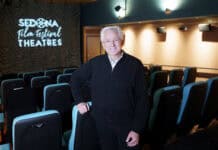The Emerson Theater Collaborative, in partnership with the Arts Academy of Sedona, will present “Driving Miss Daisy” on Friday, Oct. 4, and Saturday, Oct. 5, at 7 p.m., and on Sunday, Oct. 6, at 2 p.m. in Brady Hall at the Verde Valley School, located at 3511 Verde Valley School Road. General admission tickets are $35.
ETC’s production features Joan Westmoreland as Daisy Werthan, Ernest Pittman as her chauffeur, Hoke Colburn, and James Yaw as Daisy’s son Boolie Werthan.
“As a director, I think Hoke taught Daisy how to be a human being,” Director Camilla Ross said. “There’s a lot of layers to this show in terms of relationships. Hoke as the chauffeur came with his dignity as a person, and I think that’s all he ever wanted is dignity and respect. He had to take care of his family. It was a job. But I don’t think that Hoke was subservient, he did a job, and within that job there are things he had to do to survive.”
This is Westmoreland’s seventh performance with ETC and will follow her previous local debut as Ouiser “Weezer” Bourdeaux in Red Earth Theatre’s production of “Steel Magnolias” in 2019 after she relocated to Sedona from San Diego.
“I wanted to play Daisy for 20 years,” Westmoreland said. “Because I saw her, like most white people, as a sweet little old lady, and that ‘Driving Miss Daisy’ was a wonderful comedy. But now that I’m being directed in it, I’m seeing the other side of her, which is the prejudiced side of her. Most people are familiar with the film, which doesn’t play the bigotry very much, but the play does. If you listen to the lines, you’ll see how nasty she is without realizing it … Now I realize it’s not just a comedy, it’s a drama.”
“Daisy, at the beginning of the play, and for most of the play, is a terrible bigot,” Westmoreland said. The play covers a 25-year period beginning in 1948 and follows the title character’s development of dementia. “But she doesn’t think she is, because she was born just a few years after the end of the Civil War, so she’s not lived in any situation that wasn’t Jim Crow. So she doesn’t think she is superior … Because [Hoke] drives her for 25 years, she realizes that he is her best friend and that he’s been there when her son has not been able to. And by the end of the play, when she begins to enter into her dementia stage, she realizes he is her best friend and always has been, and she realizes that she has been prejudiced, even though three times throughout the play she denies it.”
Ross said that one of the most poignant scenes to her is the moment in which Hoke is driving Daisy to Mobile, Ala., but the two miss a turn because Daisy didn’t read the map properly, for which she blames him, followed by Daisy denying Hoke’s request to use the restroom so they could make up for lost time.
“To me, [it] was so inhuman,” Ross said. “He says to her, ‘I couldn’t stop at the last gas station because they wouldn’t allow me there, and she didn’t have any compassion for him. He stops anyway, and he says to her, ‘Who are you to tell me when I have to use the restroom? I know what I have to go, I’m a man, and I know when my needs need to be met.’ He stops, and he says to he says, ‘I’m going to go out here, and I’m going to find a place to go and I’m taking the keys with me.’ He leaves her in the dark, and she has to think about who she is, why she is, in the dark. It’s that moment that she recognizes and sees him as human, as opposed to treating him with the day’s protocol.”
“Despite [Daisy’s] bigotry, she’s a sweet little old Southern lady and, regardless of her terrible behavior in the beginning, you got to love her,” Westmoreland said. “That’s the difficult thing to play, her prejudice and yet her adorableness. Her son is faced with that same dilemma: He loves her, but he sees her for who she is. What I hope to do is let the audience see the unconscious bigotry and yet not blame her for it. For the audience to somehow accept that’s how she is, and she can’t change until the last minute … and that they just love her for who she is deep down.”
The Saturday, Oct. 5, performance will be preceded by a sampling of Southern foods and music at 5 p.m.; tickets are an additional $20. To purchase tickets, visit bit.ly/aas-driving-daisy or call (860) 705-9711, and for more information, visit EmersonTheaterCollaborative.org
